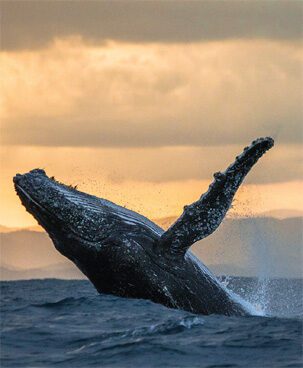Whale watching season is here, so find out how to be a considerate observer of these ocean giants
BY ALEX DRISCOLL
With the appearance of a young humpback whale in Manly Cove in late April, it seemed that nature was signalling the beginning of the whale season on the Northern Beaches. This offers locals and tourists alike a chance to watch these gracious ocean giants make their journey north to the warmer tropical waters for mating.
However, despite their imposing size, whales are sensitive creatures, and its vital that we are conscious of our impact when watching, especially if we are on the water. While docile animals for the most part, an upset whale is not something to take lightly. So to ensure both our safety and theirs, here are some quick tips about how to be a safe and considerate whale watcher.
The first thing to remember is that the minimum distance you can keep from a whale while on the water is 100 metres if you are on a general powered or non-powered vessel. This distance increases to 300 metres if you are on a personal watercraft (such as a jet ski) or if a calf is present. These measures help ensure that a collision is unlikely to occur, and you are not at risk of being landed on if the whale decides to breach the water.
Jet ski safety is of particular importance. The Organisation for the Rescue and Research of Cetaceans (ORRCA) highlights a number of other precautions you should be taking when approaching a whale: “You should start your approach at an angle of at least 30 degrees to their direction of travel. This helps you to avoid cutting across their path or putting your vessel directly in front of, or behind them.

“If there are other vessels approaching, wait your turn. No more than two vessels should approach at a time. It’s also important to let the whale dictate the interaction.”
They also highlighted what to do if a whale approaches your vehicle: “Stop or slow down to minimise your wash. Move away or disengage your vessel’s gears. Avoid making any sudden movement and minimise noise.”
For those brave enough to get into the water with whales, ORRCA has some other safety tips. Like with jet skis, allow the whale to control the interaction. Always keep a safe distance, never reach out to touch the animal, and avoid swimming close to calves, lest you want attention from a protective mother.
Whale watching, when done safely, can be a once-in-a-lifetime experience. So if you want to see these majestic giants up close, be sure to recall these tips.
Best whale watching spots on the Northern Beaches
If heading out on the water is a little intimidating (or you are prone to some sea sickness), here are the best spots from dry land to catch the whales going up the ‘humpback highway.’
- Manly North Head offers stunning views far out to the ocean, and it’s an ideal spot for a picnic.
- Barrenjoey Lighthouse is a 1km uphill walk, located in the Ku-ring-gai Chase National Park.
- Curly Boardwalk is a great spot to casually stop at and try your luck at spotting whales.








